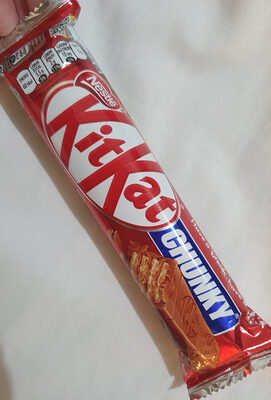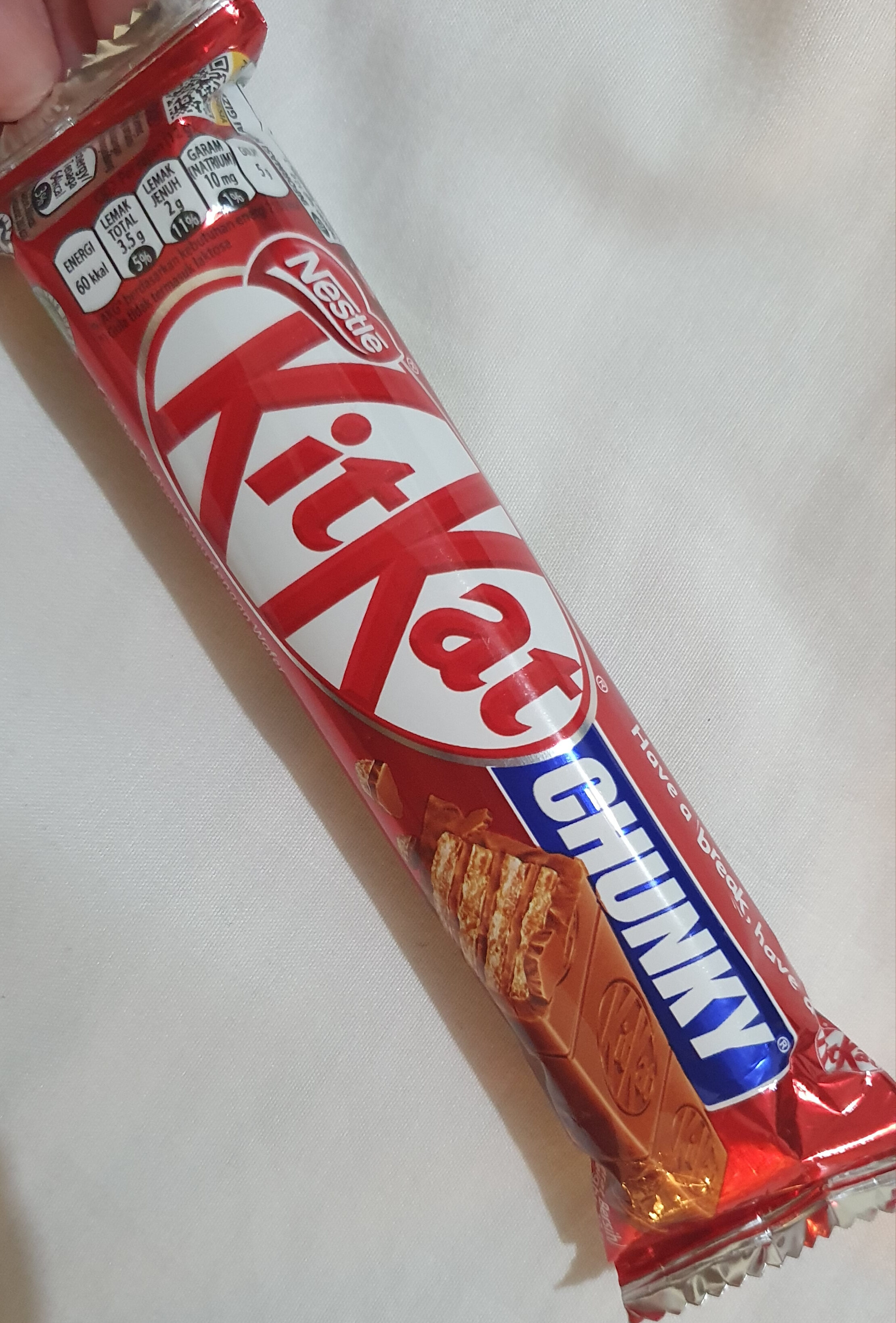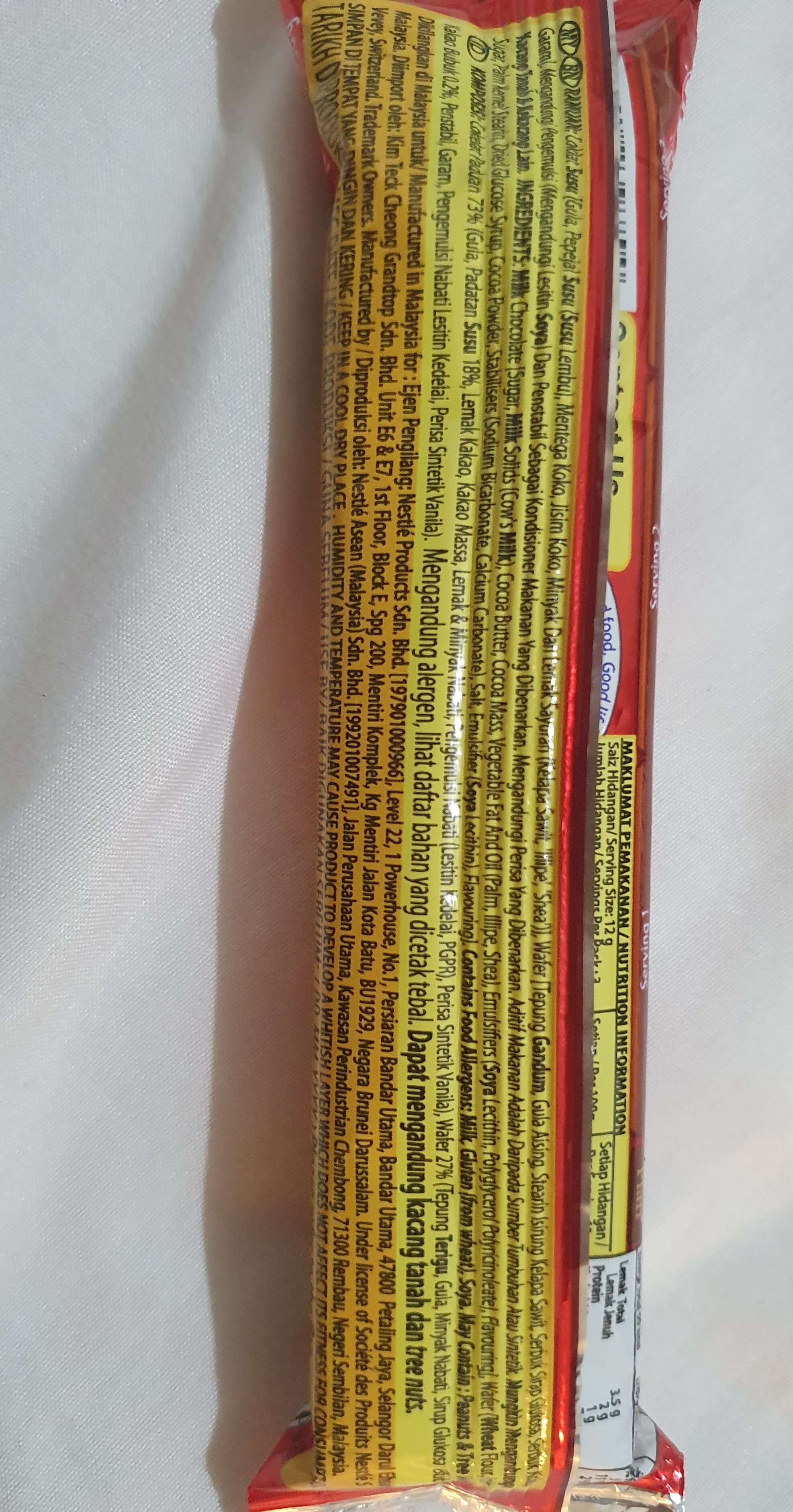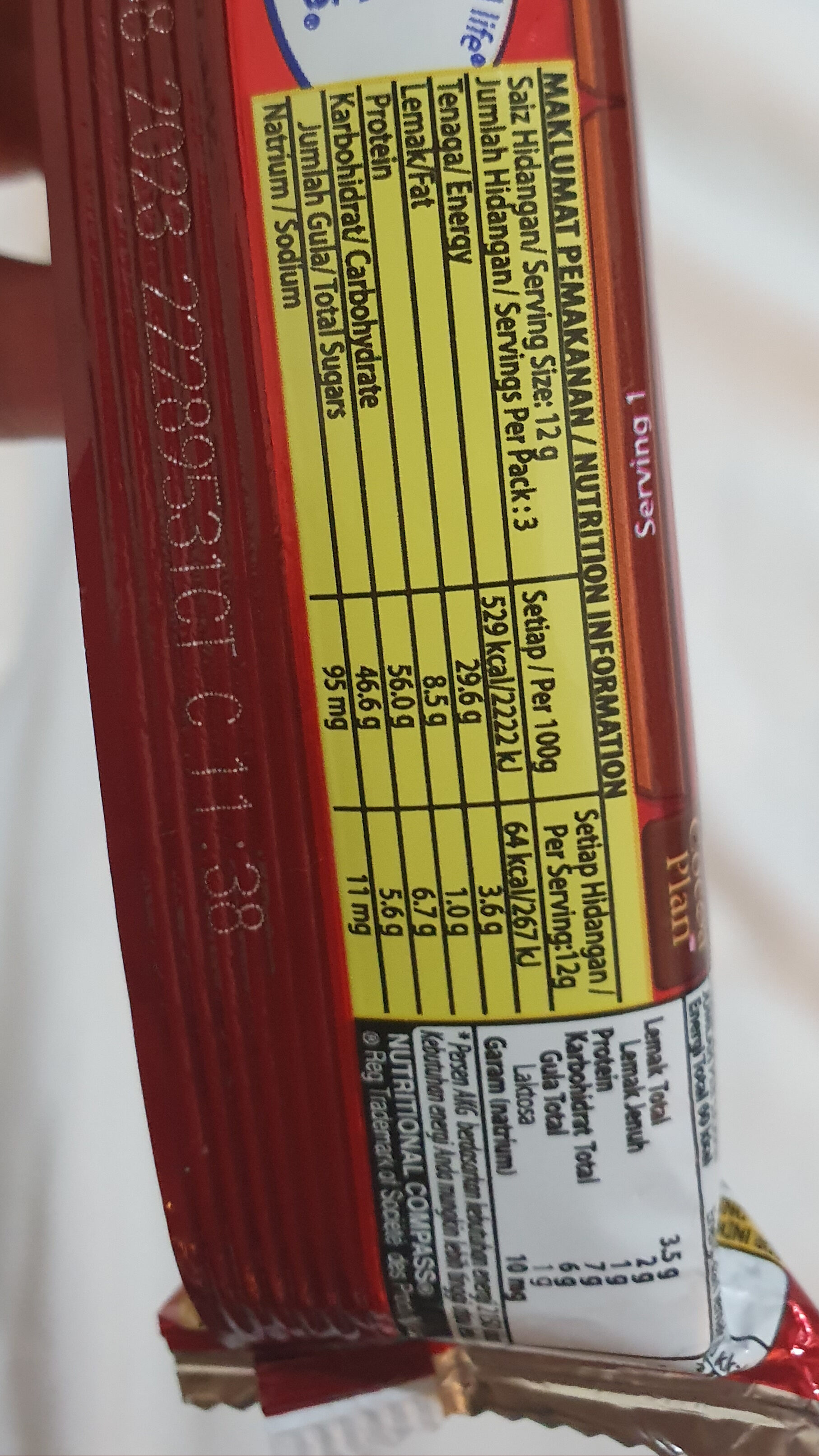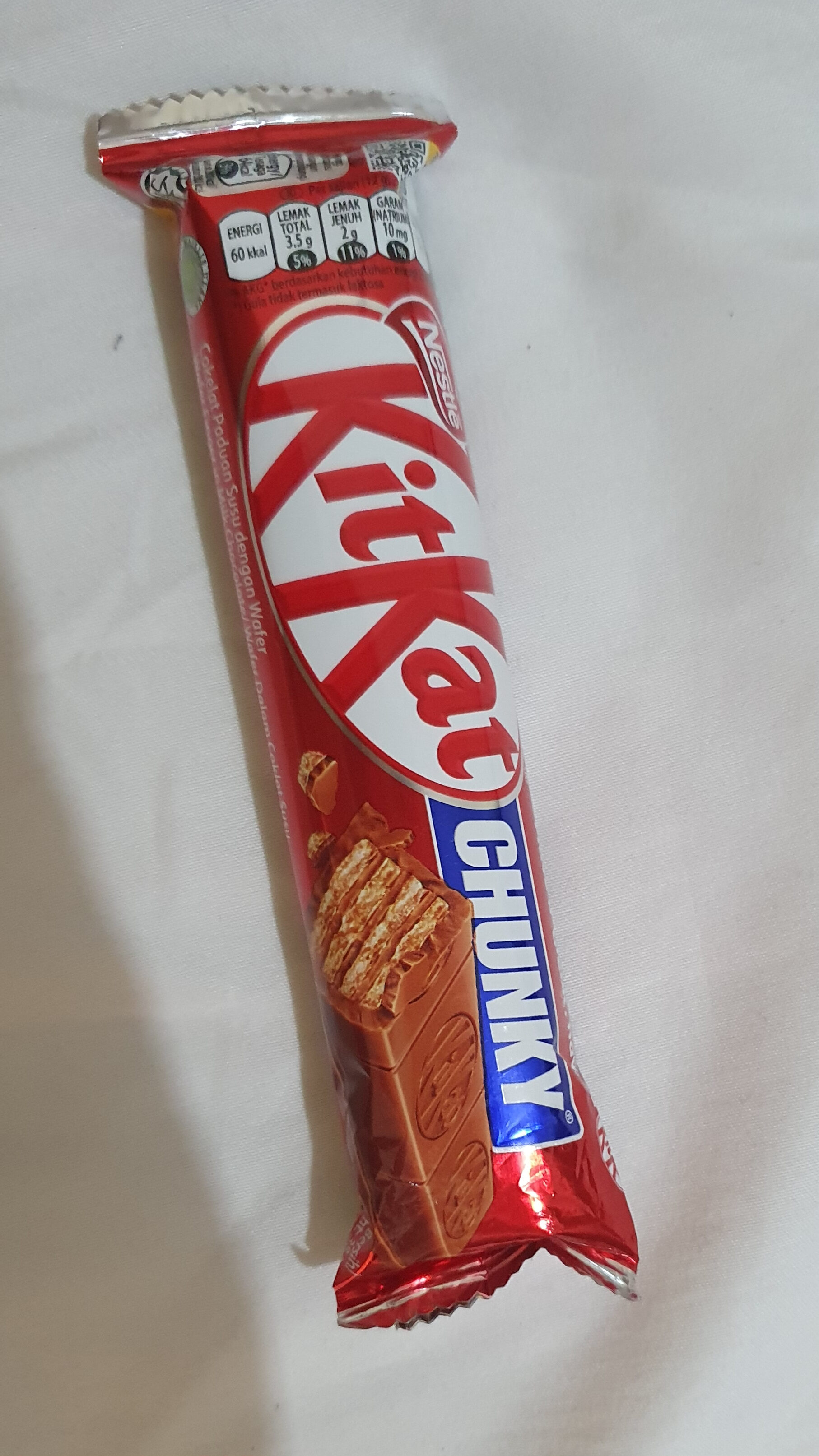Bantu kami menjadikan transparansi makanan sebagai norma!
Sebagai organisasi nirlaba, kami bergantung pada donasi Anda untuk terus memberikan informasi kepada konsumen di seluruh dunia tentang apa yang mereka makan.
Revolusi makanan dimulai dari Anda!
KitKat Chunky - Nestle - 38
KitKat Chunky - Nestle - 38
Halaman produk ini tidak lengkap. Anda dapat membantu melengkapinya dengan menyunting dan menambahkan lebih banyak data dari foto yang kami sediakan, atau dengan mengambil lebih banyak foto menggunakan aplikasi yang tersedia untuk Android atau iPhone/iPad. Terima kasih!
×
Kode batang: 9556001239754 (EAN / EAN-13)
Kuantitas: 38
Merek - merek: Nestle
Kategori: en:Snacks, en:Sweet snacks, en:Cocoa and its products, en:Confectioneries, en:Bars, en:Chocolate candies, en:bars-covered-with-chocolate
Label, sertifikasi, penghargaan:
Halal, en:Pure cocoa butter
Negara tempat dijual: Indonesia
Menyesuaikan dengan preferensi Anda
Kesehatan
bahan
-
27 bahan
Coklat Susu (Gula, Pepejal Susu (Susu Lembu), Mentega Koko, Jisim Koko, Minyak Dair ternak Sayuran (Kelapa Sawit, Hipe, Shea)), Water [Tepung Gandum, Gula Aising, Stearin Isirung Kelapa Sawit, Serbuk Sirap Gilukosa, Serbuk ko Garami, Mengandungi Pengemuisi (Mengandungi Lesitin Soya) Dan Penstabil Sebagai Kondisioner Makanan Yang Dibenarkan. Mengandungi Perisa Yang Dibenarkan.Alergen - alergen: en:Gluten, en:Milk, en:Soybeans
Pengolahan makanan
-
Makanan olahan ultra
Elemen yang menunjukkan bahwa produk berada dalam grup en:4 - Ultra processed food and drink products:
- Zat aditif: E322
- Zat aditif: E476
- Bahan: Emulsifier
- Bahan: Flavouring
- Bahan: Glukosa
- Bahan: Glucose syrup
Produk makanan diklasifikasikan ke dalam 4 kelompok sesuai dengan tingkat pengolahannya:
- Makanan - makanan yang tidak diproses atau sedikit diproses
- Bahan - bahan kuliner olahan
- Makanan olahan
- Makanan olahan ultra
Penentuan kelompok didasarkan pada kategori produk dan bahan-bahan yang dikandungnya.
Zat - zat aditif
-
E322
Lecithin: Lecithin -UK: , US: , from the Greek lekithos, "egg yolk"- is a generic term to designate any group of yellow-brownish fatty substances occurring in animal and plant tissues, which are amphiphilic – they attract both water and fatty substances -and so are both hydrophilic and lipophilic-, and are used for smoothing food textures, dissolving powders -emulsifying-, homogenizing liquid mixtures, and repelling sticking materials.Lecithins are mixtures of glycerophospholipids including phosphatidylcholine, phosphatidylethanolamine, phosphatidylinositol, phosphatidylserine, and phosphatidic acid.Lecithin was first isolated in 1845 by the French chemist and pharmacist Theodore Gobley. In 1850, he named the phosphatidylcholine lécithine. Gobley originally isolated lecithin from egg yolk—λέκιθος lekithos is "egg yolk" in Ancient Greek—and established the complete chemical formula of phosphatidylcholine in 1874; in between, he had demonstrated the presence of lecithin in a variety of biological matters, including venous blood, in human lungs, bile, human brain tissue, fish eggs, fish roe, and chicken and sheep brain. Lecithin can easily be extracted chemically using solvents such as hexane, ethanol, acetone, petroleum ether, benzene, etc., or extraction can be done mechanically. It is usually available from sources such as soybeans, eggs, milk, marine sources, rapeseed, cottonseed, and sunflower. It has low solubility in water, but is an excellent emulsifier. In aqueous solution, its phospholipids can form either liposomes, bilayer sheets, micelles, or lamellar structures, depending on hydration and temperature. This results in a type of surfactant that usually is classified as amphipathic. Lecithin is sold as a food additive and dietary supplement. In cooking, it is sometimes used as an emulsifier and to prevent sticking, for example in nonstick cooking spray.Sumber: Wikipedia (Bahasa Inggris)
-
E322i - Lesitin
Lecithin: Lecithin -UK: , US: , from the Greek lekithos, "egg yolk"- is a generic term to designate any group of yellow-brownish fatty substances occurring in animal and plant tissues, which are amphiphilic – they attract both water and fatty substances -and so are both hydrophilic and lipophilic-, and are used for smoothing food textures, dissolving powders -emulsifying-, homogenizing liquid mixtures, and repelling sticking materials.Lecithins are mixtures of glycerophospholipids including phosphatidylcholine, phosphatidylethanolamine, phosphatidylinositol, phosphatidylserine, and phosphatidic acid.Lecithin was first isolated in 1845 by the French chemist and pharmacist Theodore Gobley. In 1850, he named the phosphatidylcholine lécithine. Gobley originally isolated lecithin from egg yolk—λέκιθος lekithos is "egg yolk" in Ancient Greek—and established the complete chemical formula of phosphatidylcholine in 1874; in between, he had demonstrated the presence of lecithin in a variety of biological matters, including venous blood, in human lungs, bile, human brain tissue, fish eggs, fish roe, and chicken and sheep brain. Lecithin can easily be extracted chemically using solvents such as hexane, ethanol, acetone, petroleum ether, benzene, etc., or extraction can be done mechanically. It is usually available from sources such as soybeans, eggs, milk, marine sources, rapeseed, cottonseed, and sunflower. It has low solubility in water, but is an excellent emulsifier. In aqueous solution, its phospholipids can form either liposomes, bilayer sheets, micelles, or lamellar structures, depending on hydration and temperature. This results in a type of surfactant that usually is classified as amphipathic. Lecithin is sold as a food additive and dietary supplement. In cooking, it is sometimes used as an emulsifier and to prevent sticking, for example in nonstick cooking spray.Sumber: Wikipedia (Bahasa Inggris)
-
E476
Polyglycerol polyricinoleate: Polyglycerol polyricinoleate -PGPR-, E476, is an emulsifier made from glycerol and fatty acids -usually from castor bean, but also from soybean oil-. In chocolate, compound chocolate and similar coatings, PGPR is mainly used with another substance like lecithin to reduce viscosity. It is used at low levels -below 0.5%-, and works by decreasing the friction between the solid particles -e.g. cacao, sugar, milk- in molten chocolate, reducing the yield stress so that it flows more easily, approaching the behaviour of a Newtonian fluid. It can also be used as an emulsifier in spreads and in salad dressings, or to improve the texture of baked goods. It is made up of a short chain of glycerol molecules connected by ether bonds, with ricinoleic acid side chains connected by ester bonds. PGPR is a yellowish, viscous liquid, and is strongly lipophilic: it is soluble in fats and oils and insoluble in water and ethanol.Sumber: Wikipedia (Bahasa Inggris)
-
E500
Sodium carbonate: Sodium carbonate, Na2CO3, -also known as washing soda, soda ash and soda crystals, and in the monohydrate form as crystal carbonate- is the water-soluble sodium salt of carbonic acid. It most commonly occurs as a crystalline decahydrate, which readily effloresces to form a white powder, the monohydrate. Pure sodium carbonate is a white, odorless powder that is hygroscopic -absorbs moisture from the air-. It has a strongly alkaline taste, and forms a moderately basic solution in water. Sodium carbonate is well known domestically for its everyday use as a water softener. Historically it was extracted from the ashes of plants growing in sodium-rich soils, such as vegetation from the Middle East, kelp from Scotland and seaweed from Spain. Because the ashes of these sodium-rich plants were noticeably different from ashes of timber -used to create potash-, they became known as "soda ash". It is synthetically produced in large quantities from salt -sodium chloride- and limestone by a method known as the Solvay process. The manufacture of glass is one of the most important uses of sodium carbonate. Sodium carbonate acts as a flux for silica, lowering the melting point of the mixture to something achievable without special materials. This "soda glass" is mildly water-soluble, so some calcium carbonate is added to the melt mixture to make the glass produced insoluble. This type of glass is known as soda lime glass: "soda" for the sodium carbonate and "lime" for the calcium carbonate. Soda lime glass has been the most common form of glass for centuries. Sodium carbonate is also used as a relatively strong base in various settings. For example, it is used as a pH regulator to maintain stable alkaline conditions necessary for the action of the majority of photographic film developing agents. It acts as an alkali because when dissolved in water, it dissociates into the weak acid: carbonic acid and the strong alkali: sodium hydroxide. This gives sodium carbonate in solution the ability to attack metals such as aluminium with the release of hydrogen gas.It is a common additive in swimming pools used to raise the pH which can be lowered by chlorine tablets and other additives which contain acids. In cooking, it is sometimes used in place of sodium hydroxide for lyeing, especially with German pretzels and lye rolls. These dishes are treated with a solution of an alkaline substance to change the pH of the surface of the food and improve browning. In taxidermy, sodium carbonate added to boiling water will remove flesh from the bones of animal carcasses for trophy mounting or educational display. In chemistry, it is often used as an electrolyte. Electrolytes are usually salt-based, and sodium carbonate acts as a very good conductor in the process of electrolysis. In addition, unlike chloride ions, which form chlorine gas, carbonate ions are not corrosive to the anodes. It is also used as a primary standard for acid-base titrations because it is solid and air-stable, making it easy to weigh accurately.Sumber: Wikipedia (Bahasa Inggris)
-
E500ii - Natrium bikarbonat
Sodium carbonate: Sodium carbonate, Na2CO3, -also known as washing soda, soda ash and soda crystals, and in the monohydrate form as crystal carbonate- is the water-soluble sodium salt of carbonic acid. It most commonly occurs as a crystalline decahydrate, which readily effloresces to form a white powder, the monohydrate. Pure sodium carbonate is a white, odorless powder that is hygroscopic -absorbs moisture from the air-. It has a strongly alkaline taste, and forms a moderately basic solution in water. Sodium carbonate is well known domestically for its everyday use as a water softener. Historically it was extracted from the ashes of plants growing in sodium-rich soils, such as vegetation from the Middle East, kelp from Scotland and seaweed from Spain. Because the ashes of these sodium-rich plants were noticeably different from ashes of timber -used to create potash-, they became known as "soda ash". It is synthetically produced in large quantities from salt -sodium chloride- and limestone by a method known as the Solvay process. The manufacture of glass is one of the most important uses of sodium carbonate. Sodium carbonate acts as a flux for silica, lowering the melting point of the mixture to something achievable without special materials. This "soda glass" is mildly water-soluble, so some calcium carbonate is added to the melt mixture to make the glass produced insoluble. This type of glass is known as soda lime glass: "soda" for the sodium carbonate and "lime" for the calcium carbonate. Soda lime glass has been the most common form of glass for centuries. Sodium carbonate is also used as a relatively strong base in various settings. For example, it is used as a pH regulator to maintain stable alkaline conditions necessary for the action of the majority of photographic film developing agents. It acts as an alkali because when dissolved in water, it dissociates into the weak acid: carbonic acid and the strong alkali: sodium hydroxide. This gives sodium carbonate in solution the ability to attack metals such as aluminium with the release of hydrogen gas.It is a common additive in swimming pools used to raise the pH which can be lowered by chlorine tablets and other additives which contain acids. In cooking, it is sometimes used in place of sodium hydroxide for lyeing, especially with German pretzels and lye rolls. These dishes are treated with a solution of an alkaline substance to change the pH of the surface of the food and improve browning. In taxidermy, sodium carbonate added to boiling water will remove flesh from the bones of animal carcasses for trophy mounting or educational display. In chemistry, it is often used as an electrolyte. Electrolytes are usually salt-based, and sodium carbonate acts as a very good conductor in the process of electrolysis. In addition, unlike chloride ions, which form chlorine gas, carbonate ions are not corrosive to the anodes. It is also used as a primary standard for acid-base titrations because it is solid and air-stable, making it easy to weigh accurately.Sumber: Wikipedia (Bahasa Inggris)
Analisis kandungan bahan
-
en:Palm oil
Bahan-bahan yang mengandung minyak kelapa sawit: en:Palm
-
en:Non-vegan
Bahan-bahan non-vegan: en:Milk chocolate, en:Milk solids, en:Cow's milkBeberapa bahan tidak dapat dikenali.
Kami membutuhkan bantuan Anda!
Anda dapat membantu kami mengenali lebih banyak bahan dan dengan lebih baik menganalisis daftar kandungan bahan untuk produk ini dan lainnya dengan:
- Sunting halaman produk ini untuk memperbaiki kesalahan ejaan dalam daftar kandungan bahan, dan/atau untuk menghapus kandungan bahan dalam bahasa dan kalimat lain yang tidak terkait dengannya.
- Tambahkan entri baru, sinonim, atau terjemahan ke daftar kandungan bahan, metode pemrosesan bahan, dan label multibahasa kami.
Bergabunglah dengan saluran #ingredients di ruang diskusi Slack kami dan/atau pelajari tentang analisis bahan di wiki kami, jika Anda ingin membantu. Terima kasih!
-
en:Vegetarian status unknown
Bahan-bahan yang tidak dikenal: en:Wafer, en:sugar-icing, en:palm-kernel-stearinBeberapa bahan tidak dapat dikenali.
Kami membutuhkan bantuan Anda!
Anda dapat membantu kami mengenali lebih banyak bahan dan dengan lebih baik menganalisis daftar kandungan bahan untuk produk ini dan lainnya dengan:
- Sunting halaman produk ini untuk memperbaiki kesalahan ejaan dalam daftar kandungan bahan, dan/atau untuk menghapus kandungan bahan dalam bahasa dan kalimat lain yang tidak terkait dengannya.
- Tambahkan entri baru, sinonim, atau terjemahan ke daftar kandungan bahan, metode pemrosesan bahan, dan label multibahasa kami.
Bergabunglah dengan saluran #ingredients di ruang diskusi Slack kami dan/atau pelajari tentang analisis bahan di wiki kami, jika Anda ingin membantu. Terima kasih!
-
Detail analisis kandungan bahan
Kami membutuhkan bantuan Anda!
Beberapa bahan tidak dapat dikenali.
Kami membutuhkan bantuan Anda!
Anda dapat membantu kami mengenali lebih banyak bahan dan dengan lebih baik menganalisis daftar kandungan bahan untuk produk ini dan lainnya dengan:
- Sunting halaman produk ini untuk memperbaiki kesalahan ejaan dalam daftar kandungan bahan, dan/atau untuk menghapus kandungan bahan dalam bahasa dan kalimat lain yang tidak terkait dengannya.
- Tambahkan entri baru, sinonim, atau terjemahan ke daftar kandungan bahan, metode pemrosesan bahan, dan label multibahasa kami.
Bergabunglah dengan saluran #ingredients di ruang diskusi Slack kami dan/atau pelajari tentang analisis bahan di wiki kami, jika Anda ingin membantu. Terima kasih!
en: Milk Chocolate (Sugar, Milk Solids (Cow's Milk), Cocoa Butter, Cocoa Mass, Dried Glucose Syrup, Vegetable Fat, Oil (Palm, Illipe, Shea), Emulsifiers (Soya Lecithin, Polyglycerol Polyricinoleate), Natural Flavouring, Wafer, Wheat Flour, Sugar Icing, Sugar, Palm Kernel Stearin, Cocoa Powder, Stabilizers (Sodium Bicarbonate, Calcium Carbonate), Emulsifier (Soya Lecithin))- Milk Chocolate -> en:milk-chocolate - vegan: no - vegetarian: yes - ciqual_food_code: 31004 - percent_min: 100 - percent_max: 100
- Sugar -> en:sugar - vegan: yes - vegetarian: yes - ciqual_proxy_food_code: 31016 - percent_min: 5.88235294117647 - percent_max: 100
- Milk Solids -> en:milk-solids - vegan: no - vegetarian: yes - ciqual_proxy_food_code: 19051 - percent_min: 0 - percent_max: 50
- Cow's Milk -> en:cow-s-milk - vegan: no - vegetarian: yes - ciqual_proxy_food_code: 19051 - percent_min: 0 - percent_max: 50
- Cocoa Butter -> en:cocoa-butter - vegan: yes - vegetarian: yes - ciqual_food_code: 16030 - percent_min: 0 - percent_max: 33.3333333333333
- Cocoa Mass -> en:cocoa-paste - vegan: yes - vegetarian: yes - ciqual_proxy_food_code: 16030 - percent_min: 0 - percent_max: 25
- Dried Glucose Syrup -> en:dehydrated-glucose-syrup - vegan: yes - vegetarian: yes - ciqual_proxy_food_code: 31016 - percent_min: 0 - percent_max: 20
- Vegetable Fat -> en:vegetable-fat - vegan: yes - vegetarian: yes - from_palm_oil: maybe - percent_min: 0 - percent_max: 16.6666666666667
- Oil -> en:oil - vegan: maybe - vegetarian: maybe - from_palm_oil: maybe - percent_min: 0 - percent_max: 14.2857142857143
- Palm -> en:palm - vegan: yes - vegetarian: yes - from_palm_oil: yes - ciqual_food_code: 16129 - percent_min: 0 - percent_max: 14.2857142857143
- Illipe -> en:illipe-oil - vegan: yes - vegetarian: yes - from_palm_oil: no - percent_min: 0 - percent_max: 7.14285714285714
- Shea -> en:shea-butter - vegan: yes - vegetarian: yes - from_palm_oil: no - percent_min: 0 - percent_max: 4.76190476190476
- Emulsifiers -> en:emulsifier - percent_min: 0 - percent_max: 12.5
- Soya Lecithin -> en:soya-lecithin - vegan: yes - vegetarian: yes - ciqual_food_code: 42200 - percent_min: 0 - percent_max: 12.5
- Polyglycerol Polyricinoleate -> en:e476 - vegan: yes - vegetarian: yes - percent_min: 0 - percent_max: 6.25
- Natural Flavouring -> en:natural-flavouring - vegan: maybe - vegetarian: maybe - percent_min: 0 - percent_max: 5
- Wafer -> en:wafer - percent_min: 0 - percent_max: 5
- Wheat Flour -> en:wheat-flour - vegan: yes - vegetarian: yes - ciqual_proxy_food_code: 9410 - percent_min: 0 - percent_max: 5
- Sugar Icing -> en:sugar-icing - percent_min: 0 - percent_max: 5
- Sugar -> en:sugar - vegan: yes - vegetarian: yes - ciqual_proxy_food_code: 31016 - percent_min: 0 - percent_max: 5
- Palm Kernel Stearin -> en:palm-kernel-stearin - percent_min: 0 - percent_max: 5
- Cocoa Powder -> en:cocoa-powder - vegan: yes - vegetarian: yes - ciqual_food_code: 18100 - percent_min: 0 - percent_max: 5
- Stabilizers -> en:stabiliser - percent_min: 0 - percent_max: 5
- Sodium Bicarbonate -> en:e500ii - vegan: yes - vegetarian: yes - percent_min: 0 - percent_max: 5
- Calcium Carbonate -> en:e170i - vegan: maybe - vegetarian: maybe - percent_min: 0 - percent_max: 2.5
- Emulsifier -> en:emulsifier - percent_min: 0 - percent_max: 5
- Soya Lecithin -> en:soya-lecithin - vegan: yes - vegetarian: yes - ciqual_food_code: 42200 - percent_min: 0 - percent_max: 5
kandungan nutrisi
-
Data yang hilang untuk menghitung Nutri-Score
Kandungan gizi yang hilang
⚠ ️Fakta nutrisi produk harus disebutkan secara spesifik untuk menghitung Nutri-Score.Bisakah Anda menambahkan informasi yang diperlukan untuk menghitung Nutri-Score? Tambahkan nilai gizi
-
Tingkat - tingkat kandungan gizi
-
Lemak di kuantitas tinggi (28.7%)
Apa yang perlu anda ketahui- Konsumsi lemak yang tinggi, terutama lemak jenuh, dapat meningkatkan kolesterol, yang meningkatkan risiko penyakit jantung.
Rekomendasi: Kurangi konsumsi lemak dan lemak jenuh- Pilihlah produk dengan kandungan lemak dan lemak jenuh yang lebih rendah.
-
Gula di kuantitas tinggi (44%)
Apa yang perlu anda ketahui- Konsumsi gula yang tinggi dapat menyebabkan kenaikan berat badan dan kerusakan gigi. Hal ini juga meningkatkan risiko diabetes tipe 2 dan penyakit kardiovaskular.
Rekomendasi: Batasi konsumsi gula dan minuman manis- Minuman manis (seperti soda, minuman buah, dan jus buah serta nektar) harus dibatasi sebisa mungkin (tidak lebih dari 1 gelas sehari).
- Pilihlah produk dengan kandungan gula yang lebih rendah dan kurangi konsumsi produk dengan gula tambahan.
-
Garam di kuantitas rendah (0.168%)
Apa yang perlu anda ketahui- Konsumsi garam (atau natrium) yang tinggi dapat menyebabkan peningkatan tekanan darah, yang dapat meningkatkan risiko penyakit jantung dan stroke.
- Banyak orang yang memiliki tekanan darah tinggi tidak mengetahuinya, karena sering kali tidak ada gejala.
- Kebanyakan orang mengonsumsi terlalu banyak garam (rata-rata 9 hingga 12 gram per hari), sekitar dua kali lipat dari tingkat asupan maksimum yang direkomendasikan.
Rekomendasi: Batasi konsumsi garam dan makanan asin- Kurangi jumlah garam yang digunakan saat memasak, dan jangan beri garam lagi di meja.
- Batasi konsumsi camilan asin dan pilihlah produk dengan kandungan garam yang lebih rendah.
-
-
Informasi nilai gizi
Informasi nilai gizi Seperti yang dijual
untuk 100 g / 100 mlSeperti yang dijual
per sajian (38g)Dibandingkan dengan: en:Sweet snacks Energi 2.200 kj
(526 kcal)836 kj
(200 kcal)+67% Lemak 28,7 g 10,9 g +73% Lemak jenuh ? ? Karbohidrat 58,9 g 22,4 g +22% Gula 44 g 16,7 g +126% Serat Pangan ? ? Protein 6,9 g 2,62 g +26% Garam 0,168 g 0,064 g -36% Fruits‚ vegetables‚ nuts and rapeseed‚ walnut and olive oils (estimate from ingredients list analysis) 0 % 0 %
Lingkungan
-
Eco-Score tidak dihitung - Dampak lingkungan tidak diketahui
Kami tidak dapat menghitung Eco-Score produk ini karena ada beberapa data yang hilang, bisakah Anda membantu melengkapinya?Bisakah Anda menambahkan kategori produk yang tepat sehingga kami dapat menghitung Skor Ramah Lingkungan? Tambahkan kategori
Kemasan
-
Kemasang dengan dampak sedang
-
Bagian kemasan
1 x Wrapper 38g (92 C/X)
-
Bahan kemasan
Material % Berat kemasan
-
Transportasi
-
Asal-usul bahan
Informasi asal usul bahan tidak ada
⚠ ️ Asal -usul bahan produk ini tidak disebutkan.
Jika mereka ditunjukkan pada kemasan, Anda bisa memodifikasi lembar produk dan menambahkannya.
Jika Anda adalah produsen produk ini, Anda bisa mengirimkan kami informasinya dengan platform gratis bagi produsen kami.Tambahkan asal bahan untuk produk ini Tambahkan asal bahan untuk produk ini
Spesies terancam
-
Mengandung minyak sawit
Mendorong deforestasi dan mengancam spesies seperti orangutan
Hutan tropikal di Asia, Afrika dan Amerika Latin dihancurkan untuk membuat dan memperluas perkebunan pohon kelapa sawit. Deforestasi berkontribusi terhadap perubahan iklim, dan ia membahayakan spesies seperti orangutan, gajah kerdil, dan badak Sumatera.
Report a problem
-
Incomplete or incorrect information?
Category, labels, ingredients, allergens, nutritional information, photos etc.
If the information does not match the information on the packaging, please complete or correct it. Open Food Facts is a collaborative database, and every contribution is useful for all.
Sumber - sumber data
Produk - produk ditambahkan pada oleh foodless
Penyuntingan terakhir halaman produk pada oleh ibwocoruytrc.
Halaman produk juga disunting oleh foodvisor, khansakhlsh14.
